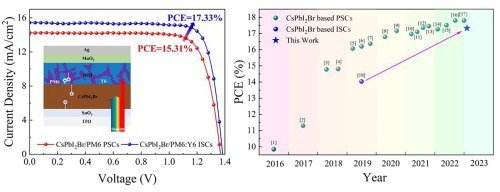17.3% efficiency CsPbI2Br solar cells by integrating a Near-infrared absorbed organic Bulk-heterojunction layer
Qiang Guo, Zheng Dai, Chuanqi Dong, Yuanjia Ding, Naizhong Jiang, Zhibin Wang, Lei Gao, Chen Duan, Qing Guo, Erjun Zhou,
17.3% efficiency CsPbI2Br solar cells by integrating a Near-infrared absorbed organic Bulk-heterojunction layer,
Chemical Engineering Journal, Volume 461, 2023, 142025, ISSN 1385-8947,
https://doi.org/10.1016/j.cej.2023.142025.
All-inorganic perovskite solar cells (PSCs) offer excellent thermal stability, but lag in power conversion efficiency compared to hybrid PSCs. Researchers integrated a low bandgap organic active layer (PM6:Y6) to CsPbI2Br PSCs, extending the photo-response range, improving short-circuit current density, and boosting efficiency from 15.31% to 17.33%. This promising strategy demonstrates enhanced performance and deeper understanding of carrier transfer in integrated solar cells.
Transient photovoltage (TPV) and transient photocurrent (TPC) were performed on a Fluxim Paios characterization system with light intensity about 0.278 sun.

